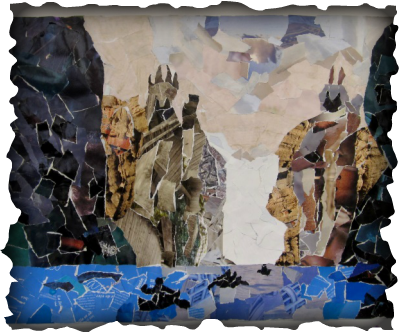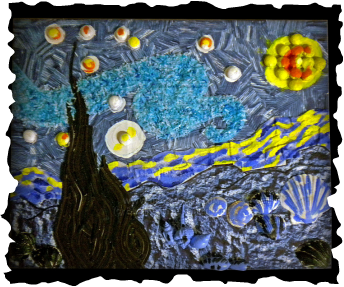Reconstructing Scenery
Collage
Art Educator: Sinthia Cousineau
Grade: 4-6
Time Frame: 2 sessions (1 hr. each)
Grade: 4-6
Time Frame: 2 sessions (1 hr. each)
"Project Prototype" by Sinthia Cousineau
Using Recycled Magazines
Rationale:
Specific Objectives:
- This lesson will enable children to practice their art skills by recreating their favourite sceneries from famous paintings, movies or photographs.
Specific Objectives:
- Students will learn how to recreate an image of a painting using the method of collage making.
- Students will produce original images inspired by another artwork (famous or not), thus also learning about that artist.
- Students will learn to recreate colors using magazine images to resemble the collages of the original image. They will use colors and composition that resemble the original.
- Students will research a painting of scenery or landscape of their choice using a computer to inspire their collage. Thus, they are incorporating technology with art.
- Students will be able to discuss the aspects that inspired them about their chosen painting & compare the original image to their recreation.
- Students will acquire a basic understanding of the composition of space within landscape art.
- Students will produce an artwork that demonstrates foreground, middle ground and background.
- Students will gain a better understanding of how to create depth in art.
Visual Art Competencies
To Produce Individual Works in the Visual Arts
- Students will produce original images inspired by another artwork (famous or not), thus also learning about that artist.
- Students will acquire a basic understanding of the composition of space within landscape art.
- Students will produce an artwork that demonstrates foreground, middle ground and background.
- Students will be able to discuss the aspects that inspired them about their chosen painting & compare the original image to their recreation.
Cross-Curricular Competencies
To use Creativity
- Students will learn to recreate colors using magazine images to resemble the collages of the original image. They will use colors and composition that resemble the original but maintaining the originality of their own work.
To Adopt Effective Work Methods
- Students will learn how to recreate an image of a painting using the method of collage making by choosing their image and visualising the colors they plan to use. The students will then plan the design of their artwork and manage their time appropriately to construct their work .
To use information and communication technologies (ICT)
- Students will research a painting of scenery or landscape of their choice using a computer to inspire their collage. Thus, they are incorporating technology with art.
“A collage reproduction of a Manet’s Painting”
(Image taken from internet)
(Image taken from internet)
Vocabulary
Background: The part of a picture of scene that appears to be farthest from the viewer, usually near the horizon. It's the opposite of the foreground
Middle ground: The part of an artwork that lies between the foreground and the background
Foreground: The area of a picture of field of vision, often at the bottom, that appears to be closest to the viewer
Overlapping: When one thing lies over, partly covering something else. Doing this is one the best ways of creating an illusion of depth
Texture: An element of art which refers to the surface quality or feel of an object, its smoothness, roughness, etc. Texture may be actual or fake. Actual textures can be actually felt, while pretend textures are suggested by an artist in the painting of different areas
Composition: The plan, placement or arrangement of the elements and objects in a work of art
Horizon: The Line that separates earth from sky
Middle ground: The part of an artwork that lies between the foreground and the background
Foreground: The area of a picture of field of vision, often at the bottom, that appears to be closest to the viewer
Overlapping: When one thing lies over, partly covering something else. Doing this is one the best ways of creating an illusion of depth
Texture: An element of art which refers to the surface quality or feel of an object, its smoothness, roughness, etc. Texture may be actual or fake. Actual textures can be actually felt, while pretend textures are suggested by an artist in the painting of different areas
Composition: The plan, placement or arrangement of the elements and objects in a work of art
Horizon: The Line that separates earth from sky
Lesson Sequence
Introduction:
Day 1:
Demonstration:
Day 2:
Example:
Step 1: Picking an Image you would like to reproduce
Step 2: Tracing the key elements of that image and drawing them on the large foam core board.
Step 3: Gluing the magazine paper, construction paper, tissue paper or other materials onto the foam core so that it resembles the original image.
Work-Time:
Day 1:
Note: This could also be done for homework if the teacher runs out of time. Homework could also involve students gathering different kinds of paper materials to use for their collage project.
Day 2:
Clean-up:
Students will recycle all unneeded paper materials which they have no used for their collage. They will clean the tables and return all art supplies to its proper place. They will give their finished collage to the teacher to display in front of the class on the wall (5mins).
Closure:
Day 1:
- Introduce the lesson with a PowerPoint presentation about scenery art which shows some of the famous landscape paintings. Towards the end of the presentation discuss the art of collage making & show some images of famous collage works (30 mins).
- Discuss with students the requirements of the project. Show them a prototype of the project. Discuss the materials which students are allowed to use for their collage making (5 mins).
Demonstration:
Day 2:
Example:
Step 1: Picking an Image you would like to reproduce
Step 2: Tracing the key elements of that image and drawing them on the large foam core board.
Step 3: Gluing the magazine paper, construction paper, tissue paper or other materials onto the foam core so that it resembles the original image.
Work-Time:
Day 1:
- Give students an opportunity to research their ideas after the PowerPoint presentation. Students could either use computers to research their images & print that image or take a photograph of it. Students could also look through art books and pick an image from there to photocopy (30 mins).
Note: This could also be done for homework if the teacher runs out of time. Homework could also involve students gathering different kinds of paper materials to use for their collage project.
Day 2:
- Students will begin to glue and ensemble their collage ideas onto the foam core board. They will organize the paper materials they wish to use for their collages & share them among their peers. The entire class time will be dedicated to starting and finishing the collage. (40 mins).
Clean-up:
Students will recycle all unneeded paper materials which they have no used for their collage. They will clean the tables and return all art supplies to its proper place. They will give their finished collage to the teacher to display in front of the class on the wall (5mins).
Closure:
- All the students’ artworks will be displayed next to an image of the original artwork that inspired their collage, and students will be given time to observe the works of their peers. Then students will discuss why they picked the original artwork and compare what they like or dislike about their collage in comparison to the original work (15-20mins).
- By the end of this lesson students will have a clear understanding of the elements required to give depth to landscape art. They will also have acquired knowledge about the process of making collage art.
“Collage of a Starry Night"
(Examples taken from internet)
Adaptions for Diverse Learners
- Students with visual, motor or learning disabilities will be given extra time.
- Students who finish early can read books about famous landscape artists or collage artworks.
- Those students who finish early can also help their peers organize the materials needed to complete their collage, or can clean the classroom or help the teacher display the artworks.
“Painting by Nicolas Poussin that shows the elements of foreground, middle ground and background”
| reconstructing_collage.docx |
The Lesson Plan







